The Wildlife Trusts’ annual round-up of life in UK seas presents the highs and lows for 2023, including bait ball feeding frenzies and increased sightings of Atlantic bluefin tuna alongside the devastating impact of avian flu on seabirds.
Dr Lissa Batey, head of marine conservation at The Wildlife Trusts, said: “2023 has been a historic year for marine conservation with the creation of the first Highly Protected Marine Areas in English waters. This new gold-standard of protection will stop all damaging activities such as trawling and enables marine wildlife to recover, benefiting fishers and carbon storing habitats.
“The end of commercial whaling has brought humpbacks and fin whales back to UK waters, and measures to protect bluefin tuna has led to a spike in sightings. This fantastic fish has returned from the brink of extinction and the risk of decimating the population for a second time remains high – so it is vital that commercial fishing quotas are set realistically and rigorously enforced. When we give nature space, wildlife can recover – it’s as simple as that. We must act faster to protect the UK target of 30% of seas by 2030.”
Sightings and bail balls
There were multiple reports of bait ball feeding frenzies involving whales, dolphin, and tuna – from Scotland to Scilly. A bait ball is formed when a predator forces fish to group together into a dense ball – then gannets, cetaceans and tuna dive in to feed, creating a ‘boiling’ sea of activity.
Atlantic bluefin tuna, which grow to over 10ft and weigh more than 1,000lbs, were once common in UK waters. Overfishing caused numbers to plummet during the 20th century. Sightings became rare and the fish had all but vanished by the 1990s. A 15-year recovery plan launched in 2007 saw numbers improve and eventually, bluefin tuna was removed from IUCN’s Red List of Endangered Species. Witnesses recorded many sightings in 2023 from Devon, Cornwall, Isles of Scilly, Scotland, Alderney to Dorset where the local Wildlife Trust recorded a 9ft-long bluefin tuna washed up at Kimmeridge Bay.
The impact of avian flu
The worldwide pandemic of avian flu continued to devastate UK seabirds. While there are signs that some birds are showing immunity, vast numbers were lost including:
- 1,200 dead terns collected at Cemlyn Nature Reserve in North Wales, including over 700 sandwich tern chicks from the only nesting colony in Wales. The colony has roughly halved in size since 2022 due to the disease.
- In Scotland, hundreds of dead seabirds washed up along Aberdeenshire’s coast including kittiwakes, herring gulls and guillemots.
- Over 1000 dead birds were collected from beaches in Pembrokeshire in July.
A seabird survey by the Isles of Scilly Wildlife Trust and RSPB painted a worrying picture for one of the most significant seabird colonies in England. Findings include:
- Overall declines of 20% of seabirds since the last survey in 2015
- A loss of almost half of the islands’ seabirds in the last 30 years
- Common terns lost as an annual breeder, with kittiwakes likely to follow
- Steep declines of the greater black-backed gull, 38%, and lesser black-backed gull, 58%, and the red-listed herring gull, 40%.
You can read more on the Wildlife Trusts’ review here.
